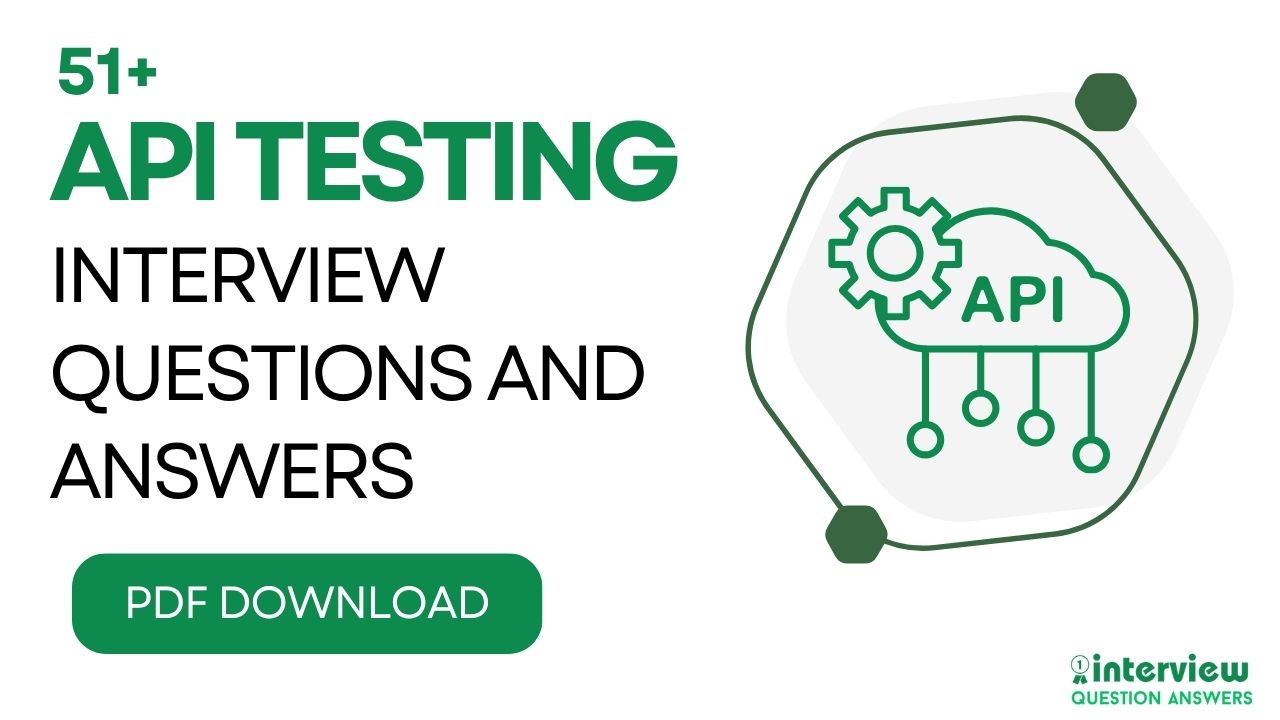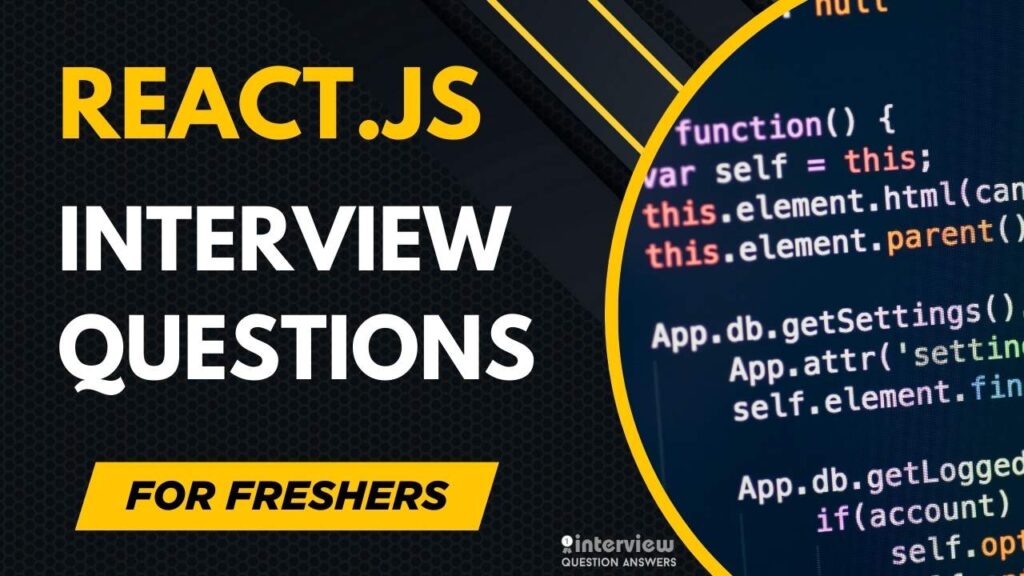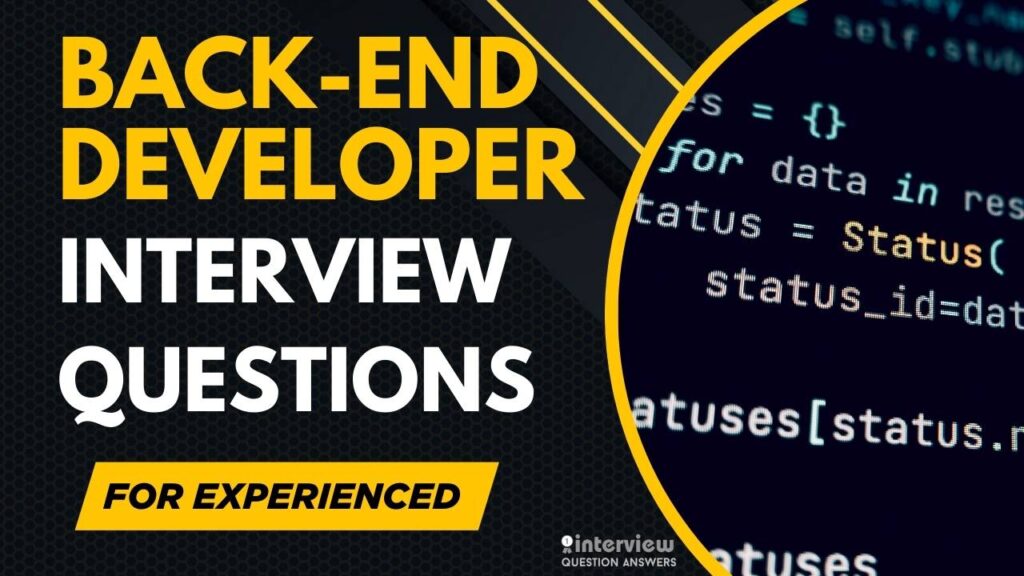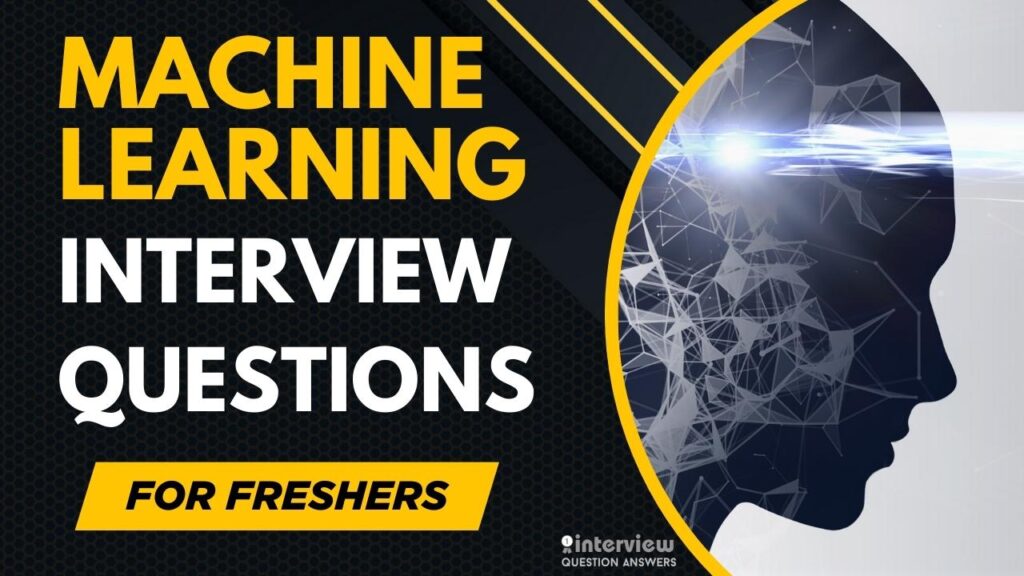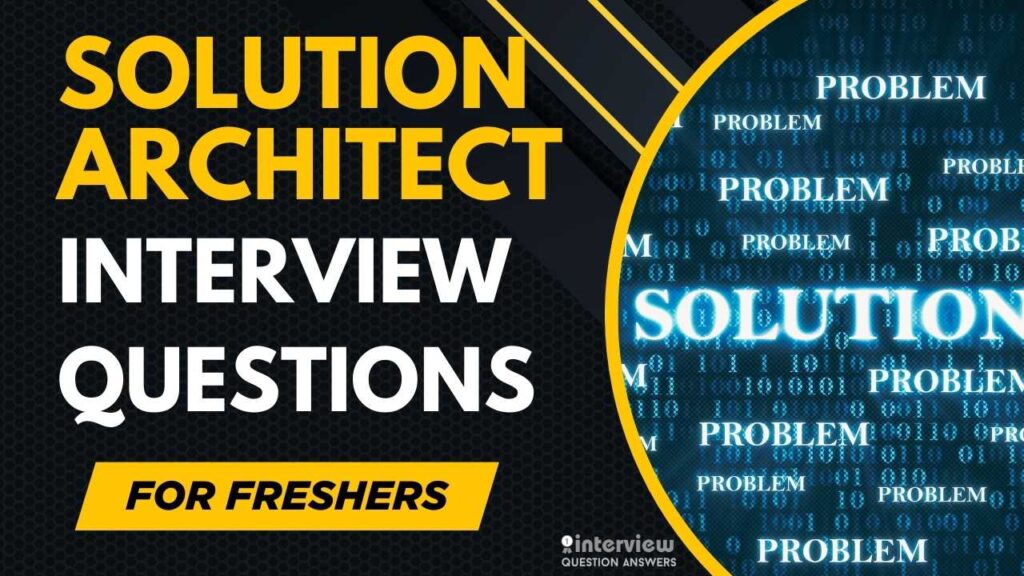API Testing professionals ensure the reliability, functionality, and performance of application programming interfaces that serve as the backbone of modern software systems. These specialists validate data exchange between different software components, verify authentication mechanisms, test response times, and ensure APIs meet specified requirements before deployment.
As organizations increasingly adopt microservices architecture and API-first development approaches, the demand for skilled API testing professionals continues to surge across industries.
This detailed interview guide provides most asked API Testing questions and answers specifically designed for API testing roles at all experience levels. We cover basic concepts and methodologies for freshers entering the API testing field, while offering advanced scenarios and complex testing strategies for experienced professionals. The guide features dedicated Postman API testing questions, focusing on this industry-standard tool that dominates API testing workflows.
Table of Contents
Basic API Testing Interview Questions and Answers for Freshers
Que 1. What are the main types of API?
Answer:
APIs can be categorized into:
- REST (Representational State Transfer)
- SOAP (Simple Object Access Protocol)
- GraphQL
- gRPC
REST and SOAP are most common in API testing, with REST being lightweight and widely used.
Que 2. What are the common HTTP methods used in API testing?
Answer:
- GET: Retrieve data
- POST: Create data
- PUT: Update data completely
- PATCH: Partially update data
- DELETE: Remove data
Que 3. What is the difference between PUT and PATCH?
Answer:
- PUT: Updates the entire resource.
- PATCH: Updates only specific fields in a resource.
Que 4. How do you test an API using Postman?
Answer:
- Set the request URL and HTTP method (GET/POST, etc.)
- Add headers, parameters, and request body
- Send the request and validate the response status code, response body, and headers
Que 5. What are the key parts of an HTTP request?
Answer:
- URL (Uniform Resource Locator)
- HTTP Method (GET, POST, etc.)
- Headers (metadata)
- Body (data payload for POST/PUT requests)
Que 6. What is the difference between authentication and authorization?
Answer:
- Authentication: Verifies user identity (e.g., username/password)
- Authorization: Determines user access rights (e.g., what resources they can access)
Que 7. What are status codes in API responses?
Answer:
- 1xx: Informational
- 2xx: Success (e.g., 200 OK, 201 Created)
- 4xx: Client errors (e.g., 400 Bad Request, 404 Not Found)
- 5xx: Server errors (e.g., 500 Internal Server Error)
Que 8. What is the difference between JSON and XML in API responses?
Answer:
| Feature | JSON | XML |
|---|---|---|
| Format | Key-value pairs | Tag-based |
| Readability | More human-readable | Less human-readable |
| Size | Lightweight | Heavier |
Que 9. How do you validate API response time?
Answer: Use tools like Postman, JMeter, or code-based validations. For example, in Postman you can write:
pm.test("Response time is less than 500ms", function () {
pm.expect(pm.response.responseTime).to.be.below(500);
});Que 10. What is the difference between SOAP and REST APIs?
Answer:
- SOAP: Protocol-based, uses XML, strict standards
- REST: Architectural style, uses multiple formats (JSON, XML), lightweight
Que 11. How do you test secured APIs?
Answer:
- Add tokens (JWT, OAuth) in headers
- Validate status codes (401 Unauthorized, 403 Forbidden)
- Ensure encryption (HTTPS) is enabled
Que 12. What is the difference between path parameters and query parameters?
Answer:
- Path parameter: Part of the URL (e.g., /users/{id})
- Query parameter: Key-value pairs after
?in the URL (e.g., /users?id=123)
Que 13. How do you handle API versioning in testing?
Answer:
- Check version numbers in URL (e.g., /v1/users)
- Validate that deprecated APIs are not used
- Ensure backward compatibility of existing APIs
Que 14. What is the use of headers in API testing?
Answer: Headers provide metadata for the request/response, such as:
- Content-Type: Defines data format (e.g., JSON)
- Authorization: Passes credentials
- Accept: Specifies expected response format
Que 15. How do you validate API responses?
Answer:
- Check status code
- Validate response body using schema validation
- Verify headers and data integrity
- Compare actual vs expected data
Que 16. What is schema validation in API testing?
Answer: Schema validation ensures that the structure of the response matches a predefined JSON or XML schema. Tools like Postman and RestAssured support schema validation.
Que 17. How do you test negative scenarios in API testing?
Answer:
- Pass invalid data or parameters
- Use incorrect authentication tokens
- Validate proper error messages and status codes (e.g., 400, 401, 404)
Que 18. How do you test APIs in automation using Java?
Answer: Use libraries like RestAssured or HttpClient:
given()
.when()
.get("https://api.example.com/users")
.then()
.statusCode(200);Que 19. How do you test rate-limited APIs?
Answer:
- Send multiple requests quickly and check for 429 Too Many Requests status code
- Validate retry-after headers if provided
Que 20. What are common challenges in API testing?
Answer:
- Handling dynamic data
- Testing dependencies between APIs
- Validating large responses
- Ensuring security (authentication, data encryption)
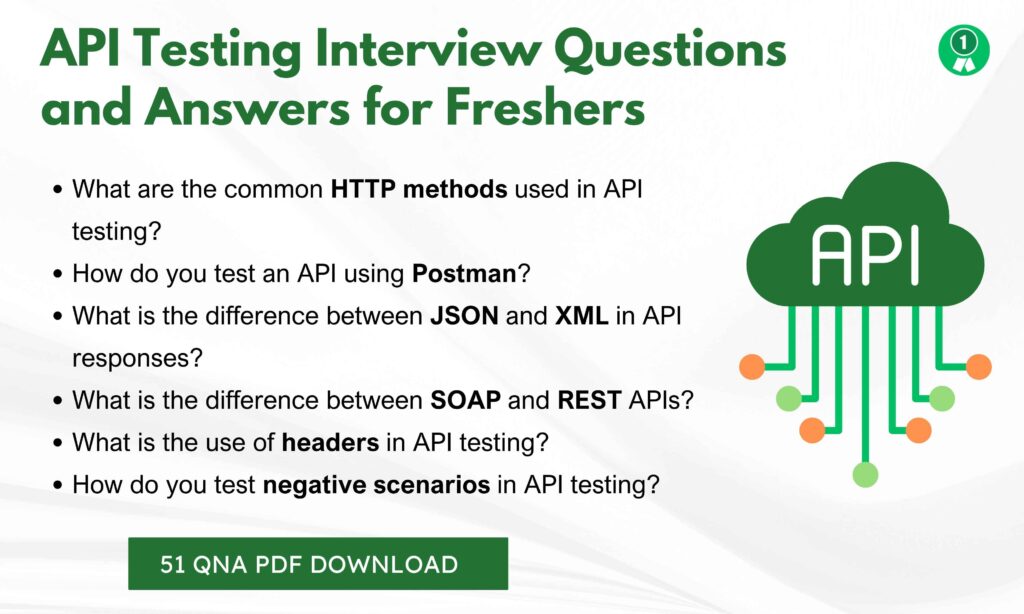
Also Check: Web API Interview Questions and Answers
API Testing Interview Questions and Answers for Experienced
Que 21. What are the key differences between REST and GraphQL APIs in terms of testing?
Answer:
- REST exposes multiple endpoints, while GraphQL uses a single endpoint with query-based data retrieval.
- Testing GraphQL requires validating the schema and query responses.
- GraphQL can overfetch or underfetch data if queries are not optimized, while REST relies on fixed endpoints.
Que 22. How do you validate API response schemas in automation?
Answer: In Java with RestAssured:
given()
.when()
.get("/users")
.then()
.assertThat()
.body(matchesJsonSchemaInClasspath("userSchema.json"));Schema validation ensures the response structure, data types, and required fields are correct.
Que 23. How do you handle dynamic data in API test automation?
Answer:
- Use regular expressions or JSONPath to extract dynamic fields (e.g., IDs).
- Chain requests: store a response value and use it in subsequent API calls.
- Implement data-driven testing with parameterized values.
Que 24. How do you perform API performance testing?
Answer: Use tools like JMeter or Gatling to test API throughput, latency, and concurrency. Validate response times under various loads and ensure SLAs are met.
Que 25. How do you test APIs integrated with message queues (e.g., RabbitMQ, Kafka)?
Answer:
- Validate the API response and ensure the message is successfully published to the queue.
- Use queue consumers to check if the message is processed correctly.
- Perform negative testing with invalid messages.
Que 26. How do you test OAuth 2.0 authentication in APIs?
Answer:
- Get an access token by hitting the token endpoint.
- Pass the token in the Authorization header (Bearer <token> ).
- Validate token expiry and refresh token functionality.
Que 27. How do you test APIs with multiple environments (Dev, QA, Prod)?
Answer:
- Externalize environment URLs and credentials.
- Use a configuration management tool or properties file to switch environments easily.
- Validate environment-specific data and rate limits.
Que 28. How do you handle API versioning in test automation?
Answer:
- Maintain separate test suites for each version (v1, v2).
- Validate backward compatibility when APIs are upgraded.
- Include tests for deprecated endpoints to ensure they are phased out correctly.
Que 29. How do you validate database changes as part of API testing?
Answer:
- Use SQL queries to verify data creation, updates, and deletions after API calls.
- Validate data integrity and referential constraints.
- Ensure rollback is handled correctly for failed transactions.
Que 30. What are idempotent APIs and how do you test them?
Answer:
- Idempotent APIs return the same result regardless of how many times the request is made (e.g., GET, PUT).
- Test by executing the same request multiple times and verifying the state remains unchanged.
Que 31. How do you test APIs with rate limits and throttling?
Answer:
- Send multiple requests in a short duration and validate 429 Too Many Requests response.
- Validate Retry-After headers for when to reattempt.
Que 32. How do you test APIs returning asynchronous responses?
Answer:
- Poll the API or callback endpoint until a specific status is returned.
- Validate intermediate statuses and final state using retry logic.
Que 33. How do you test APIs that use HMAC or custom signature authentication?
Answer:
- Generate a signature using the secret key and request payload.
- Add the signature in headers.
- Validate invalid signature scenarios return 401 Unauthorized.
Que 34. How do you handle API pagination in automation?
Answer:
- Use limit and offset or page parameters to traverse pages.
- Validate data consistency across pages and ensure no data duplication or omission.
Que 35. How do you test WebSocket APIs?
Answer:
- Establish a connection using libraries like OkHttp or Socket.IO.
- Validate handshake success and data exchange.
- Test connection timeouts, message ordering, and reconnection logic.
Que 36. How do you automate contract testing for APIs?
Answer:
- Use Pact or Postman contract tests to validate provider and consumer agreements.
- Ensure that all mandatory fields, types, and endpoints meet the agreed contract.
Que 37. How do you test APIs integrated with third-party services?
Answer:
- Mock external APIs using tools like WireMock or MockServer.
- Validate retry logic when external APIs are unavailable.
- Verify response transformations and error handling.
Que 38. How do you test APIs for security vulnerabilities?
Answer:
- Validate authentication/authorization flaws.
- Test for SQL injection, XSS, and parameter tampering.
- Check for information leakage through error messages.
Que 39. How do you test APIs for data integrity and consistency?
Answer:
- Validate all CRUD operations impact the database correctly.
- Ensure concurrent updates do not cause data corruption.
- Test rollback scenarios during partial failures.
Que 40. How do you design a robust API automation framework?
Answer:
- Use modular design with reusable request and validation methods.
- Implement data-driven testing and environment configurations.
- Integrate reporting tools (Allure, ExtentReports) and CI/CD pipelines.
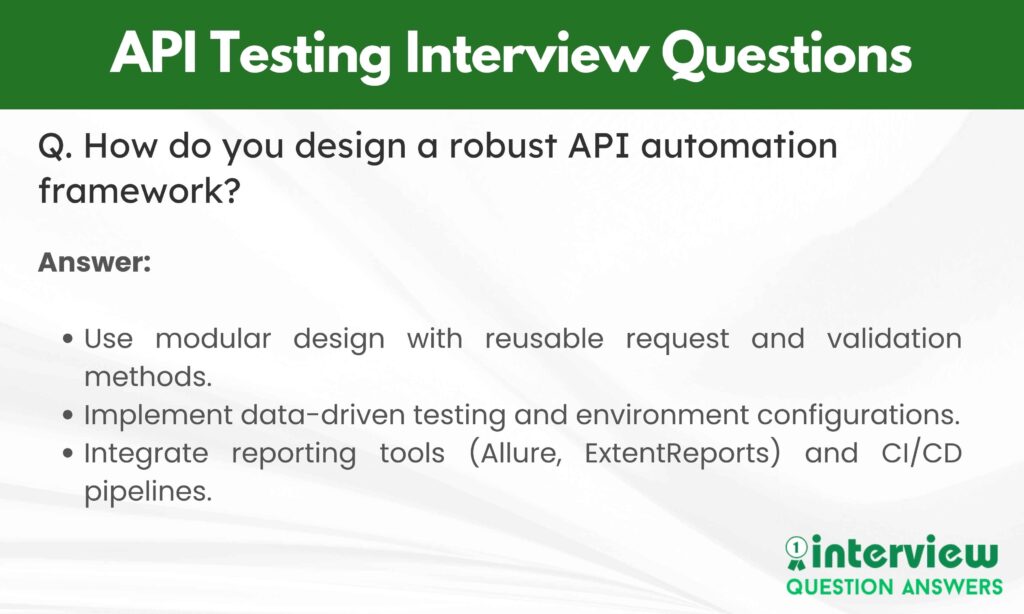
Also Check: Rest API Interview Questions and Answers
Postman API Testing Interview Questions and Answers
Que 41. What is the difference between a Collection and an Environment in Postman?
Answer:
- Collection: A group of saved API requests that can be organized and run together.
- Environment: Stores variables (like URLs, tokens) that can be reused across requests.
Using environments makes it easy to switch between development, staging, and production.
Que 42. How do you use variables in Postman?
Answer: Variables can be defined at global, environment, or collection levels. They are used with {{variableName}} syntax.
Example:
{{baseUrl}}/usersVariables can be set dynamically using scripts:
pm.environment.set("token", "12345");Que 43. How do you write basic assertions in Postman?
Answer: Postman uses the Chai assertion library:
pm.test("Status code is 200", function () {
pm.response.to.have.status(200);
});
pm.test("Response has userId", function () {
pm.expect(pm.response.json().userId).to.eql(1);
});Que 44. How do you chain requests in Postman?
Answer: Use Pre-request scripts or Tests tab to set variables from one request and use them in another:
pm.environment.set("userId", pm.response.json().id);This userID can be used in subsequent API requests.
Que 45. What is the difference between Pre-request Script and Test Script in Postman?
Answer:
| Script Type | Execution Time |
|---|---|
| Pre-request Script | Runs before the request is sent |
| Test Script | Runs after receiving the response |
Que 46. How do you run Postman Collections from the command line?
Answer: Use Newman, Postman’s CLI tool:
newman run Collection.json -e Environment.jsonNewman is widely used for CI/CD integration.
Que 47. How do you handle authentication in Postman?
Answer: Postman supports Basic Auth, Bearer Tokens, OAuth 1.0/2.0, and API keys. Tokens can be stored as variables and used dynamically in the Authorization tab or headers.
Que 48. How do you perform data-driven testing in Postman?
Answer: Use Collection Runner or Newman with data files (JSON/CSV):
newman run Collection.json -d data.csvEach iteration picks data from the input file to execute the test.
Que 49. How do you validate response headers in Postman?
Answer:
pm.test("Content-Type is JSON", function () {
pm.response.to.have.header("Content-Type", "application/json");
});Que 50. How do you use Postman for API performance testing?
Answer: Run the collection multiple times using Newman and measure response times using scripts or external tools. Postman also logs average response times in the Collection Runner.
Que 51. How do you integrate Postman/Newman with CI/CD pipelines?
Answer:
- Add Newman commands to Jenkins, GitLab CI, or Azure pipelines.
- Export environment variables dynamically.
- Generate HTML/JUnit reports for visibility:
newman run Collection.json -r cli,htmlAPI Testing Interview Questions PDF
Additionally, We have also provided a PDF so you can access all API Testing Interview Questions and answers anytime easily. You can download from the button below:
FAQs: API Testing Interview Questions
What is the typical job role of an API Tester?
An API Tester is responsible for validating the functionality, reliability, performance, and security of APIs. They design and execute test cases, automate API test scripts, verify data integrity, and ensure APIs work seamlessly with other system components.
What challenges can one face in an API Testing job?
Challenges include testing APIs without a user interface, handling dynamic data, managing dependencies across multiple APIs, ensuring backward compatibility during version upgrades, and dealing with frequent changes in requirements.
What challenges might candidates face during an API Testing interview?
Candidates may face real-world scenario-based questions involving authentication, complex data validations, error handling, and automation frameworks. They are also expected to demonstrate strong knowledge of HTTP methods, status codes, and tools like Postman or RestAssured.
What is the average salary of an API Tester in the USA?
The average salary for an API Tester in the USA ranges from $85,000 to $115,000 annually, depending on the candidate’s experience, skillset, and location. Senior roles like API Test Lead or SDET can earn above $130,000.
What skills are required to succeed in API Testing?
API Testers should have a solid understanding of HTTP protocols, REST/SOAP APIs, JSON/XML data formats, and API automation tools like Postman, Newman, RestAssured, or JMeter. Knowledge of scripting languages and CI/CD tools is also valuable.
Which top companies hire for API Testing roles?
Top companies include Google, Amazon, Microsoft, PayPal, Salesforce, IBM, Infosys, Cognizant, Accenture, and TCS. Many fintech, healthcare, and SaaS companies also have strong API testing needs.
How can you grow your career as an API Tester?
To grow, one should master API automation frameworks, security testing, performance testing, and microservices architecture. Moving toward roles like SDET, QA Lead, or Test Architect can significantly accelerate career progression.

